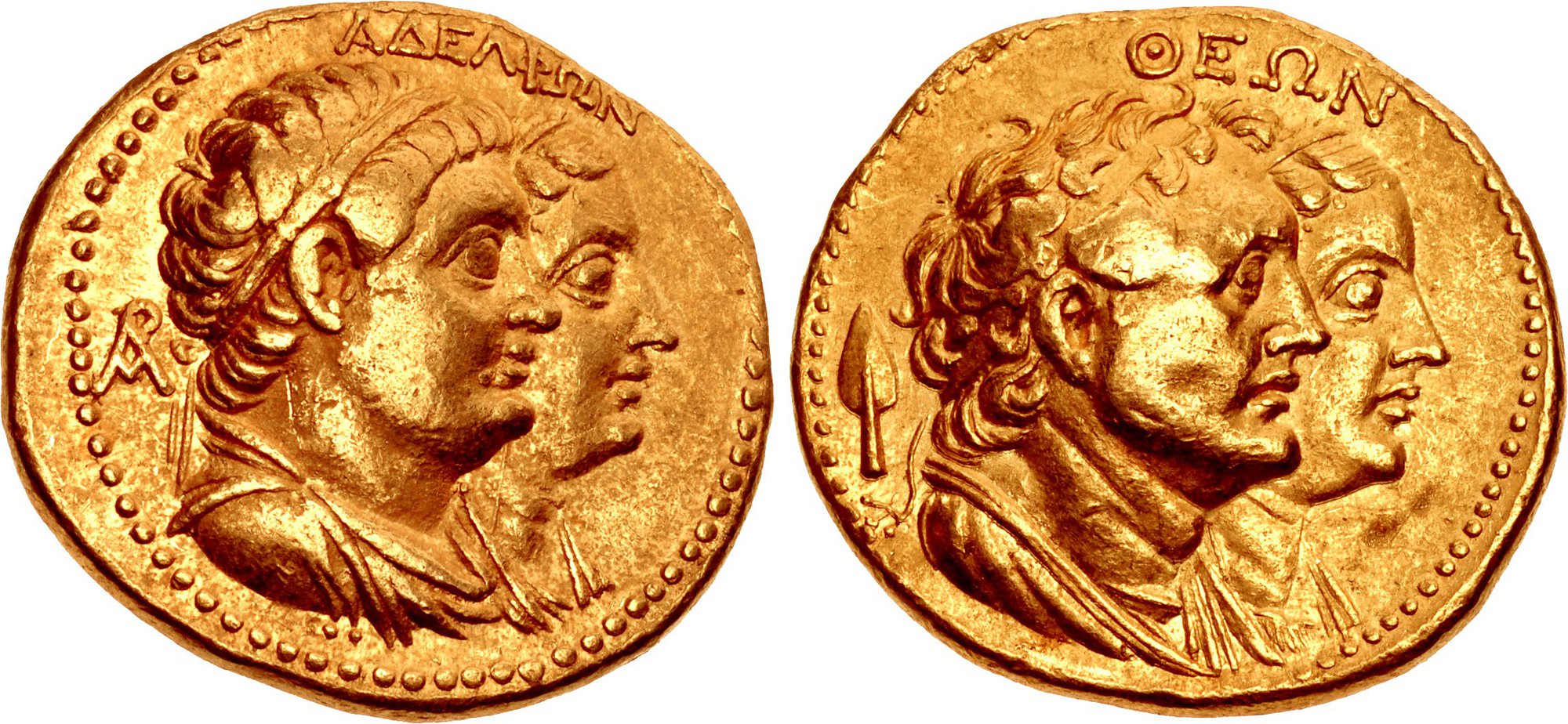S 2044 - Alexandria (Ptolemy V), gold, mnaieia (199-198 BCE)
From SILVER
199 BCE - 198 BCE Gold 19,071 kg
Description
| ObverseInscription or printing placed on the obverse.: | AΔEΛΦΩN above (Greek).Conjoined busts of Ptolemy II and Arsinöe II right, Ptolemy is diademed and draped, Arsinöe is diademed and veiled, monogram to left |
| ReverseInscription or printing placed on the reverse.: | ΘEΩN above (Greek).Conjoined busts of Ptolemy I and Berenike I, Ptolemy is diademed and draped (thunderbolt ornament on diadem), Berenike is diademed and veiled, spearhead to left |
Mint and issuing power
| MintIdentifies the place of manufacture or issue of a numismatic object.: | Alexandria | Ancient regionAncient region.: | Egypt | Modern countryModern country: Egypt | AuthorityIdentifies the issuing power. The authority can be "pretended" when the name or the portrait of X is on the coin but he/she was not the issuing power. It can also be "uncertain" when there is no mention of X on the coin but he/she was the issuing power according to the historical sources: | Ptolemaic dynasty (323-30 BC), Ptolemy V Epiphanes (Ptolemaic king, 204-181 BC) |
Chronology
| FromIdentifies the initial date in a range assigned in a numismatic context. | 199 BCE | toIdentifies the final date in a range assigned in a numismatic context.. | 198 BCE | PeriodTime period of the numismatic object.: Hellenistic 323-30 BC |
Physical description
| MetalThe physical material (usually metal) from which an object is made.: | Gold |
Median weightMedian of the weights of numismatic objects (in grams). in grams | 27.80 | DenominationTerm indicating the value of a numismatic object. Examples: tetradrachm, chalkous, denarius.: | mnaieion |
StandardStandard.: | Ptolemaic |
Image

S2044 Ptolemy V gold mnaieion.jpg [1]
References
| Die study referencePublication of the study: | Carlen 20191Carlen 2019, p. 106-107 | ||
| Coin series referenceReference to coin series study: | |||
Obverse dies distribution
| FrequencyFrequency of specimen in distribution. ᵖ | Number of obversesNumber of obverse dies. ᵖ (o) | % (o) | Number of coinsNumber of coins. (n) | % (n) | Die nameName(s) of the die(s). |
| 3 | 1 | 33.33 | 3 | 23.08 | 10 |
| 4 | 1 | 33.33 | 4 | 30.77 | 11 |
| 6 | 1 | 33.33 | 6 | 46.15 | 9 |
| Total | 3 of 3 | 99.99 | 13 of 13 | 100 |
Reverse dies distribution
no distribution is available
Quantification
| Number of obversesNumber of obverse dies. ᵖ (o) | 3 | Number of singletons (o1)The number of singleton coins. ᵖ | |
| Number of reverse diesNumber of reverse dies. (r) | 6 | Number of coinsNumber of coins. (n) | 13 |
| Coins per obverse dieNumber of coins per obverse die. (n/o) | 4.33 | Coins per reverse dieNumber of coins per reverse die. (n/r) | 2.17 |
| Reverse per obverse ratioRatio of obverse dies divided by reverse dies. (r/o) | 2 | Percentage of singletons (o1)number of coins (n) divided by the number of singletons (o1) ᵖ | % |
| Original number of dies (O) (Carter 1983 formula)The estimation of the number of coins according to Carter 1983 ᵖ | 3.43 | Coins struck if 20,000 as average productivity per dieCoins made if the average productivity for obverses (according to Carter) is 20,000. ᵖ | 68,600 |
| Original number of dies (O) (Esty 2011 formula)The estimation of the number of coins according to the singleton formula in Esty 2011 ᵖ (O) | 3.9 | Survival rate if 20,000 as average productivity per dieSurvival rate if average productivity is 20,000. ᵖ | 0.00019 |
| Coverage (o = % of O) (Esty 1984 formula)Esty 1984 - coverage (% of O) ᵖ (o = % of O) | % | Die productivity if survival rate 1/2,000Average productivity if survival rate is 1/2,000. ᵖ | 7,580.17 |
| Weight of silver (in kg) if 20,000 coins per die (O = Carter formula)Carter 1983 * Median weight * 20000 (*10 if gold or electrum) ᵖ | 19,071 kg <br /> 19,071 kg | Die productivity if survival rate 1/5,000Average productivity if survival rate is 1/5,000. ᵖ | 18,950.44 |
Remarks
Most likely one single workstation
References
- ^ Carlen Eric (2019), "The Spearhead and Monogram Coinage of Ptolemy V," American Numismatic Journal, 2nd ser., 31, p. 97-118, pl. 18-23.